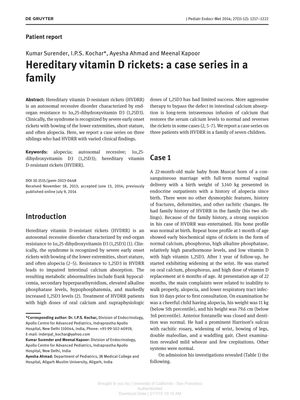TLDR Three siblings with a genetic form of rickets showed different symptoms of the disease.
The document reports on a case series involving three siblings diagnosed with hereditary vitamin D-resistant rickets (HVDRR), an autosomal recessive disorder characterized by the body's resistance to 1α,25-dihydroxyvitamin D3 (1,25D3). The clinical presentation of HVDRR typically includes severe early onset rickets, bowing of the lower extremities, short stature, and often alopecia. The siblings in this case series exhibited varied clinical findings associated with the disorder.
170 citations
,
May 1979 in “The journal of pediatrics/The Journal of pediatrics” Two sisters with rickets and hair loss had a genetic issue with vitamin D processing, and only improved when given phosphorus supplements.
151 citations
,
June 2010 in “Endocrinology and metabolism clinics of North America” Two rare genetic diseases cause severe rickets in children due to defects in vitamin D metabolism.
107 citations
,
March 2014 in “BoneKEy Reports” Mutations in the vitamin D receptor cause hereditary vitamin D-resistant rickets, leading to poor bone health and requiring high calcium doses for treatment.
30 citations
,
October 2009 in “Journal of Veterinary Internal Medicine” A Pomeranian dog had rickets due to a new gene mutation, leading to severe symptoms and euthanasia.
50 citations
,
September 2009 in “Molecular Genetics and Metabolism” A new gene mutation causes vitamin D resistance and rickets, treatable with calcium therapy.
12 citations
,
September 2014 in “Bone” A vitamin D receptor mutation causes rickets and affects immune responses.
